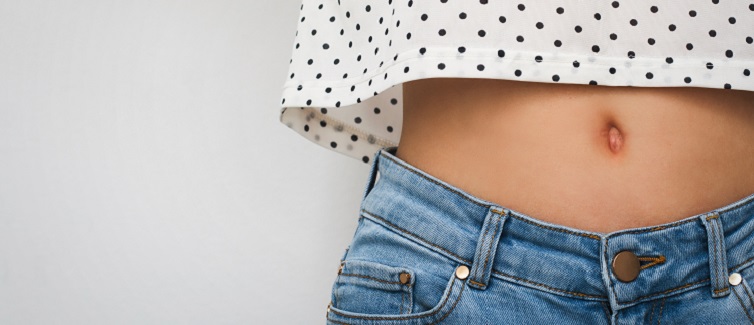Itchy Belly Button? Here's What Your Body's Trying to Tell You
An itchy belly button can have a number of causes. Most of them aren't a big deal and can be managed at home or with a quick visit to the dermatologist.
Causes of Itchy Belly Button
Here are some possible reasons for your itchy belly button, and what to do to get relief.
1. You Have Contact Dermatitis
Contact dermatitis is "dermatologist-speak" for a red, itchy rash that develops after skin has been exposed to an irritant.
Irritants can be a new soap, laundry detergent, personal care product, or a plant like poison ivy or oak. But, when it comes to bellybutton itching, the most common irritant is nickel.
"Pant buttons are usually made out of nickel, and can create a round rash where it touches the skin," says Jennifer Gordon, MD, a board-certified dermatologist with Westlake Dermatology in Austin, Texas.
Fix It
Start by pinpointing what might be causing the rash and avoiding it to stop your skin from getting further irritated.
Then apply a cool, wet compress, calamine lotion, or a 1 percent hydrocortisone cream to stop the itch as the rash heals, which can take around two to four weeks, per the Mayo Clinic.
2. You Have Eczema
Eczema — a skin condition that causes red, itchy patches and swelling — most often affects the arms and legs. But it can also affect your navel.
People who get eczema in their bellybuttons are typically already dealing with the skin condition. Most cases of eczema appear in early childhood, from genetics or environmental triggers, according to the National Eczema Association.
Fix It
Keep skin hydrated with a thick ointment, per the American Academy of Family Physicians. Your dermatologist can also help suggest natural remedies for eczema or medication to ease your symptoms.
3. You Have a Bug Bite
What are the odds that a mosquito or other bug finds its way into your bellybutton? Perhaps not that high.
But if you've got a puffy, reddish bump inside your navel that itches a lot, there's a good chance that's what happened.
For most people, mosquito bites are just an annoyance. But for others, even a mild bite can cause hives or a low-grade fever, according to the Centers for Disease Control and Prevention (CDC). In that case, you might be allergic and would need to visit an allergist.
Fix It
While mosquito bites typically fade on their own within a couple of days, there are strategies you can try to ease the itchiness and pain. Wash the area with soap and water to reduce the risk of infection. Then, apply an ice pack for 10 minutes to reduce itching and swelling, according to the CDC. You can also try an anti-itch cream like calamine lotion.
Tip
If you live in a climate where mosquitoes thrive, try applying insect repellant at night to avoid pesky bites. (Here are tips on how to safely wear an insect spray.)
4. You Have a Yeast Infection
If you have a bright red rash around your bellybutton that's itchy, swollen or even produces a bit of white discharge, you may have a yeast infection.
And if it doesn't smell, that's normal. Unlike most infections, yeast surprisingly won't make your bellybutton smell.
Fix It
If you think you have a yeast infection in your bellybutton, visit a dermatologist to see what you're truly dealing with, Dr. Garshick says. If yeast is the culprit, you'll need a prescription topical antifungal such as nystatin, miconazole, clotrimazole or ketoconazole cream.
5. You Have Intertrigo
Sometimes an itchy, burning rash is caused by an inflammatory condition called intertrigo, according to the Cleveland Clinic.
Intertrigo can happen when skin gets irritated by heat, humidity or friction (i.e., skin rubbing together). Like yeast infections, it tends to thrive on parts of the body that are warm and damp, like your bellybutton. If left untreated, intertrigo can even turn into a yeast infection, according to the National Library of Medicine.
Fix It
Keep the affected area dry and cool. Use a towel to soak up water after bathing or sweat after exercising.
Then, apply a barrier cream like Triple Paste medicated ointment, and wear loose, breathable clothing, per the Cleveland Clinic. If at-home measures don't help, visit your dermatologist, as intertrigo can get infected, Dr. Gordon says.
6. Your Piercing Is Infected
If you've got a bellybutton piercing, sweat, dead skin buildup or even an infection could be the cause of your itching and discomfort.
"Because [bellybutton piercings] create an area for moisture buildup, they may be associated with more irritation," Dr. Garshick says. Metal jewelry — especially nickel — can also cause contact dermatitis and lead to redness and itching.
Fix It
Make sure you're cleaning your piercings regularly and following any after-care instructions given by your piercer to avoid infection, per the Mayo Clinic.
7. You Have a Cyst
Cysts — small, benign bumps below the skin — can form anywhere on the body, including at the belly button. They aren't always bothersome, but sometimes, they can have a thick, yellow, or smelly discharge, or get red or itchy when infected.
Try to avoid picking or popping a cyst on your own, which can lead to infection if not cleaned properly.
Fix It
If you notice a new bump in or near your bellybutton, visit your dermatologist. Though cysts are not typically problematic, "you should always have them looked at since, given the location, they could be associated with an umbilical hernia or granuloma [area of inflammation]," Dr. Garshick says.
If the cyst feels irritated or infected, you may also need to have it drained, according to the Mayo Clinic.
When to See a Doctor
An itching bellybutton that subsides with home remedies after a few days is generally nothing to worry about.
However, you might wish to consult a dermatologist if your itching persists for longer than two weeks, keeps you from your typical activities, and affects other parts of your body.
Additionally, itching that is accompanied by even worse symptoms, such as weight loss, fever, night sweats, or open sores, may point to a more serious issue. In this situation, your physician can appropriately identify and address the problem.






.jpg)





.jpeg)
.jpg)